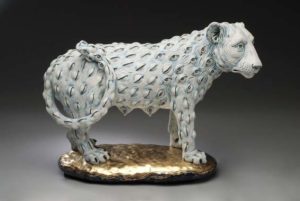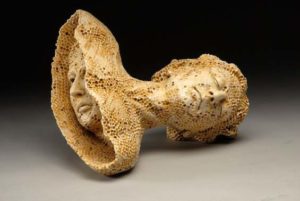
Credit: beautifuldecay.com
When we die, our bodies eventually revert back to nature, allowing new life to occupy the space that we’ve left behind. Few artists are able to capture this complex cycle of death and rebirth as accurately as Adrian Arleo. Her sculptures about loss showcase stunning, and slightly disconcerting, hybrids of humans and animals, which represent the connection that all living things have to one another.
While death imagery isn’t obvious in her ceramic pieces, it’s implied through her subjects’ facial expressions. The subjects in her sculptures often no longer occupy their own bodies, as various aspects of nature have spread into every crevice. The result is a piece that looks vaguely human, but not entirely — it’s more organic and earthy.
Some of her sculptures are more anthropomorphic than others. For instance, her piece “Branched Lives” appears to be a simple sculpture of a woman’s head at first glace. Yet when you look closely, you’ll see that the strands of her hair are slowly transforming into what looks like tree branches, with intricate honeycombs hanging from the tips of the limbs. This sculpture about loss and renewed life shows that even after our bodies die, healthy trees can grow from what we leave behind. And these trees, in turn, support the buzzing life around them.

Credit: beautifuldecay.com
Other sculptures are more animal than human, such as her piece “Lion, Awareness Series.” Here, we see a model of a lion whose fur is completely covered in eyeballs, some closed tightly and some open, staring directly at the viewer. As with her other sculptures about loss, in this series, she reminds us that every living creature embodies others that came before it and helped it become what it is today. It’s a sobering warning that we shouldn’t take our lives for granted, and that we need to show more respect for the living things that occupy the world around us.
Adrian Arleo says she was inspired to create these sculptures about loss and rebirth as she walked through the woods near her home in Montana. Everywhere she went, she would see wasp nests, detailed tree bark and tiny, delicate bird tracks in the snow. She says, “All these things are analogous to our own experiences with life cycles of birth and growth, reproduction and nurturing impulses, defense mechanisms, aging, death, decay. With the changing state of the world, I feel a greater and greater urgency to remember and express how we are all connected, all dependent on the same air, water, soil.”

Credit: beautifuldecay.com
Nearly all of Arleo’s sculptures feature wise, haggard expressions or outright expressions of sadness. She wants to convey a sense of loss — to emphasize how delicate life is and how much more we should respect it.
Yet her pieces aren’t all gloomy or filled with a sense of loss. In her sculpture “The Dreamer Awakes,” we see a dreaming woman’s bust that has been completely consumed by honeycomb. Underneath the sculpture emerges an awakened version of the same woman, representing a peaceful dream state. This piece feels distinctly more hopeful than the others, even as it spreads the same message of connectedness.
Adrian Arleo’s sculptures about loss are so nuanced that it’s sometimes difficult to spot every intricate detail. However, this is exactly what makes her pieces so powerful. They remind us, almost imperceptibly, that we all have a little bit of nature inside of us, and we have no choice but to embrace it and treat it with the respect it deserves.

 Adrian Arleo’s Sculptures About Loss Meld Nature with Humankind
Adrian Arleo’s Sculptures About Loss Meld Nature with Humankind


 Our Monthly Tip: Make an “In Case of Death” File to Ease Loved One’s Grief
Our Monthly Tip: Make an “In Case of Death” File to Ease Loved One’s Grief
 Passing of Beloved Comedian Births a New Comedy Festival
Passing of Beloved Comedian Births a New Comedy Festival















